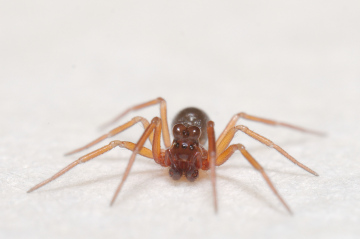Summary for Thyreosthenius biovatus (Araneae)
previous species | next species
National Distribution
Terms of Use. Double-click on map to go to region

Explore Regional Distribution
Please log on and add a note on this species
About this species
Recorded altitude range30m to 390m
Species text
DistributionRecords indicate a patchy and very scattered distribution as far north as the highlands of Scotland with the spider not recorded in some areas from which the ants Formica rufa and F. lugubris are known (see maps in Barrett (1979) and Edwards (1997)). T. biovatus is widespread in north-western and central Europe, but has not been recorded from Ireland.
Habitat and ecology
Most records are from wood-ants nests where the spider appears to be untouched by the ants, and probably lives on small flies and other small insects in the nests. Egg-sacs are laid in gaps in wood inside the nests. Both male and female spiders may be seen on the surface of the nests in autumn, and in material taken from the nests at other times of the year. It certainly occurs in both F. rufa and F. lugubris nests (Robinson 1998 and pers. comm.), and Donisthorpe reports it from a nest of F. fusca at Aviemore. It has occasionally been recorded away from ant nests (Roberts 1987).
Status
Donisthorpe (1927) states 'I have personally found both sexes of T. biovatus in every [Formica] rufa nest I have examined, from the Highlands to the South Coast of England, and in every month of the year.' Wood ants have declined appreciably over the last century, and there are relatively few recent records of the spider, certainly from northern counties. The species is no doubt under-recorded because of its specialised habitat.
Threats
Although there has been historical decline in Formica ants in Britain, there is no evidence that this continues.
Management and conservation
Ensure wood ants' (Formica spp.) nests are not destroyed or disturbed. However, not enough is known about the ecology of this species to provide firm management recommendations.
Text based on Dawson, I.K., Harvey, P.R., Merrett, P. & Russell-Smith, A.R. (in prep.). References
Adult Season
Habitats
background methodology
Recorded management for locations with Thyreosthenius biovatus
Recorded substrate and hydrology for locations with Thyreosthenius biovatus
Images
please log on and upload a new image for this speciesSee also A-Z Species Index - A-Z Picture Index - previous species | next species
